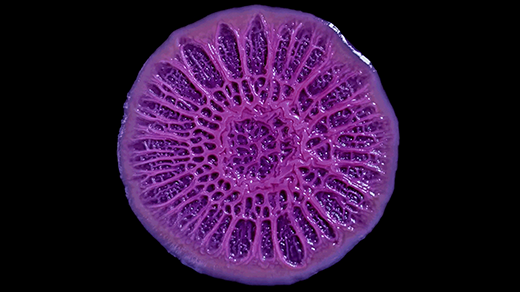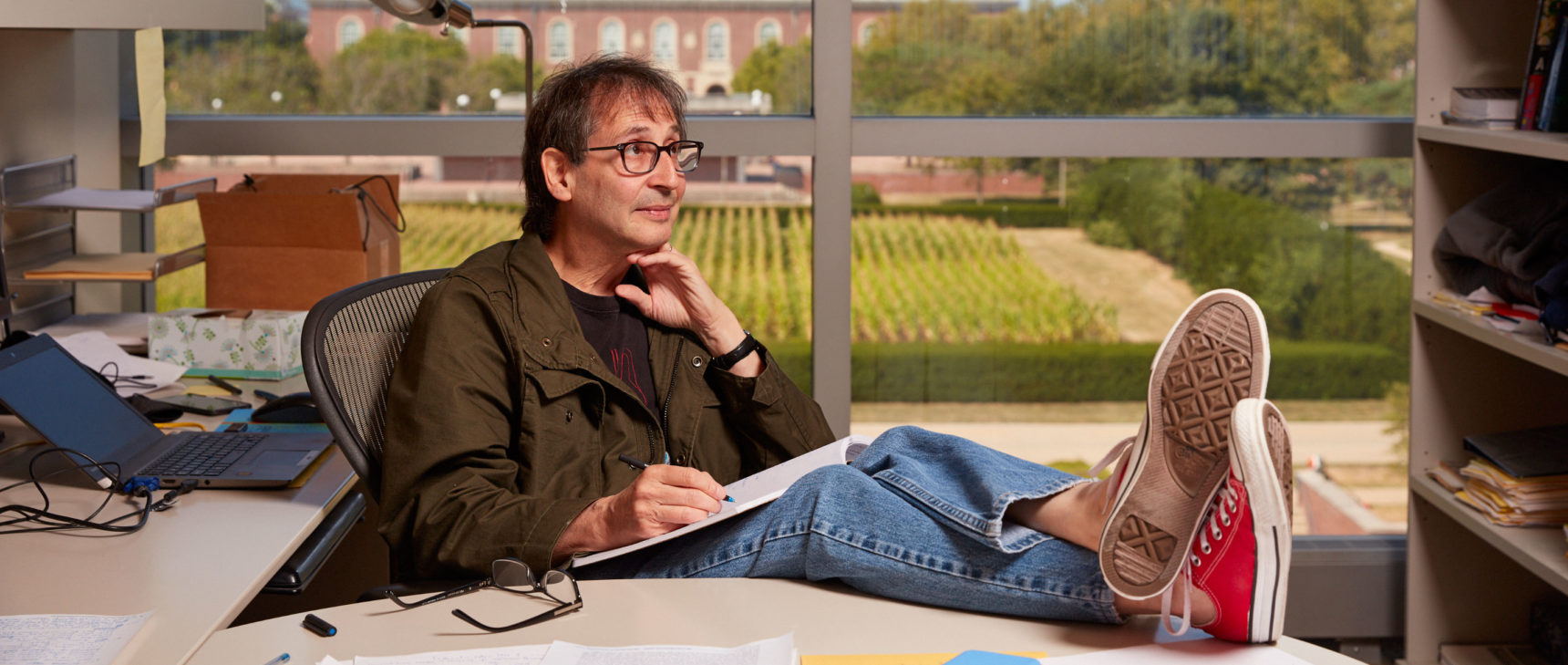Bacteria Use Brainlike Bursts of Electricity to Communicate

Olena Shmahalo/ Quanta Magazine
Introduction
Bacteria have an unfortunate — and inaccurate — public image as isolated cells twiddling about on microscope slides. The more that scientists learn about bacteria, however, the more they see that this hermitlike reputation is deeply misleading, like trying to understand human behavior without referring to cities, laws or speech. “People were treating bacteria as … solitary organisms that live by themselves,” said Gürol Süel, a biophysicist at the University of California, San Diego. “In fact, most bacteria in nature appear to reside in very dense communities.”
The preferred form of community for bacteria seems to be the biofilm. On teeth, on pipes, on rocks and in the ocean, microbes glom together by the billions and build sticky organic superstructures around themselves. In these films, bacteria can divide labor: Exterior cells may fend off threats, while interior cells produce food. And like humans, who have succeeded in large part by cooperating with each other, bacteria thrive in communities. Antibiotics that easily dispatch free-swimming cells often prove useless against the same types of cells when they’ve hunkered down in a film.
As in all communities, cohabiting bacteria need ways to exchange messages. Biologists have known for decades that bacteria can use chemical cues to coordinate their behavior. The best-known example, elucidated by Bonnie Bassler of Princeton University and others, is quorum sensing, a process by which bacteria extrude signaling molecules until a high enough concentration triggers cells to form a biofilm or initiate some other collective behavior.
But Süel and other scientists are now finding that bacteria in biofilms can also talk to one another electrically. Biofilms appear to use electrically charged particles to organize and synchronize activities across large expanses. This electrical exchange has proved so powerful that biofilms even use it to recruit new bacteria from their surroundings, and to negotiate with neighboring biofilms for their mutual well-being.
“I think these are arguably the most important developments in microbiology in the last couple years,” said Ned Wingreen, a biophysicist who researches quorum sensing at Princeton. “We’re learning about an entirely new mode of communication.”
Biofilms were already a hot topic when Süel started focusing on them as a young professor recruited to San Diego in 2012. But much about them was still mysterious, including how individual bacteria give up their freedom and settle into large, stationary societies. To gain insight, Süel and his colleagues grew biofilms of Bacillus subtilis, a commonly studied rod-shaped bacterium, and observed them for hours with sophisticated microscopes. In time-lapse movies, they saw biofilms expand outward until cells in the interior consumed the available reserves of the amino acid glutamate, which the bacteria use as a nitrogen source. Then the biofilms would stop expanding until the glutamate was replenished. Süel and his colleagues became curious about how the inner bacteria were telling the outer cells when to divide and when to chill.
Quorum sensing was the obvious suspect. But Süel, who was trained in physics, suspected that something more than the diffusion of chemical messengers was at work in his Bacillus colonies. He focused on ion channels — specialized molecules that nestle into cells’ outer membranes and ferry electrically charged particles in and out. Ion channels are probably most famous for their role in nerve cells, or neurons. Most of the time, neurons pump out sodium ions, which carry a single positive charge, and let in a different number of potassium ions, also with single positive charges. The resulting charge imbalance acts like water piling up behind a dam. When an electrical impulse jolts a neuron’s membrane, specialized channels open to allow the concentrated ions to flood in and out, essentially opening the dam’s floodgates. This exchange propagates along the neuron, creating the electrical “action potentials” that carry information in the brain.
Süel knew that bacteria also pump ions across their membranes, and several recent papers had reported spikes of electrical activity in bacteria that at least loosely resembled those found in the brain. Could bacteria also be using the action-potential mechanism to transmit electrical signals? he wondered.
He and his colleagues treated biofilms in their lab with fluorescent markers that are activated by potassium and sodium ions, and the potassium marker lit up as ions flowed out of starved cells. When the ions reached nearby cells, those cells also released potassium, refreshing the signal. The signal flowed outward in this way until it reached the biofilm’s edge. And in response to the signal, edge cells stopped dividing until the interior cells could get a meal, after which they stopped releasing potassium.
Süel’s team then created mutant bacteria without potassium channels, and they found that the cells did not grow in the same stop-start manner. (The researchers also saw no movement of labeled sodium ions in their experiments.) Like neurons, bacteria apparently use potassium ions to propagate electrical signals, Süel and his colleagues reported in Nature in 2015.
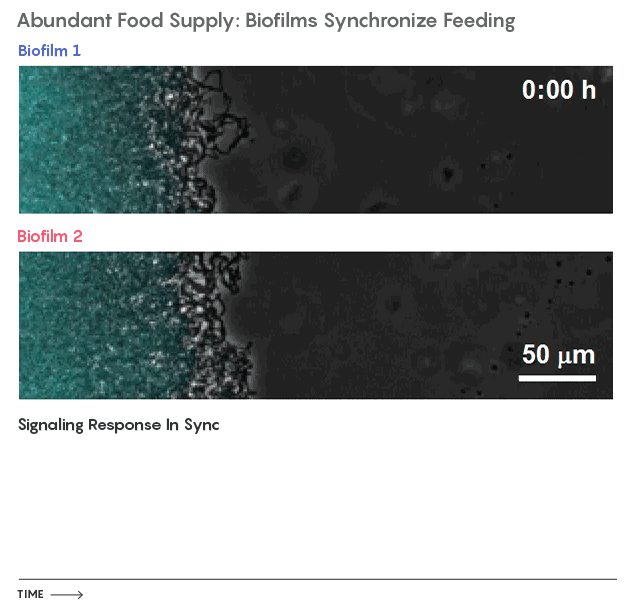
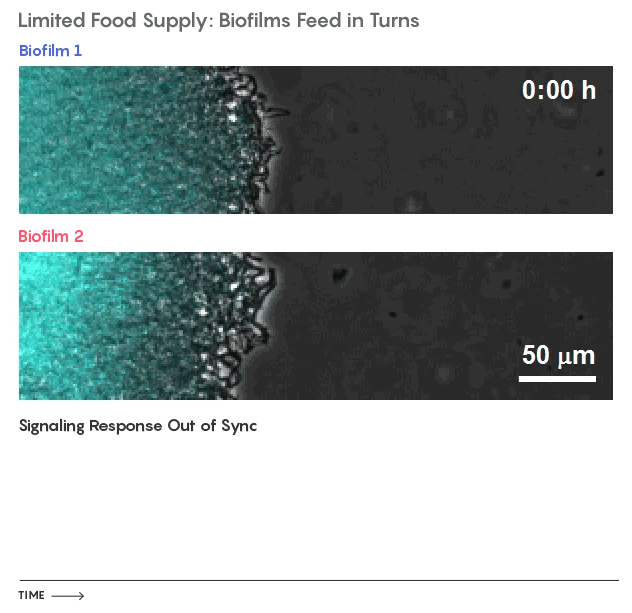
Time-lapse video of two Bacillus subtilis biofilms in a shared environment shows their synchronized growth, which the bacteria coordinate through electrical communication. Green fluorescence reveals waves of released potassium ions that sweep through the biofilms as growth signals. In Süel’s experiment, when a nutrient is plentiful (top), the two biofilms grow at the same time. Their growth signals rise and fall in sync. When the nutrient is in short supply, the two biofilms “time-share” it for more efficient consumption by growing out of phase: each grows while the other is resting.
Time-lapse video of two Bacillus subtilis biofilms in a shared environment shows their synchronized growth, which the bacteria coordinate through electrical communication. Green fluorescence reveals waves of released potassium ions that sweep through the biofilms as growth signals. In Süel’s experiment, when a nutrient is plentiful (left), the two biofilms grow at the same time. Their growth signals rise and fall in sync. When the nutrient is in short supply, the two biofilms “time-share” it for more efficient consumption by growing out of phase: each grows while the other is resting.
Adapted from Suel Lab at UCSD (Reference: J Liu et al. Science, 2017)
Despite the parallels to neural activity, Süel emphasizes that biofilms are not just like brains. Neural signals, which rely on fast-acting sodium channels in addition to the potassium channels, can zip along at more than 100 meters per second — a speed that is critical for enabling animals to engage in sophisticated, rapid-motion behaviors such as hunting. The potassium waves in Bacillus spread at the comparatively tortoise-like rate of a few millimeters per hour. “Basically, we’re observing a primitive form of action potential in these biofilms,” Süel said. “From a mathematical perspective they’re both exactly the same. It’s just that one is much faster.”
Bacterial Broadcasting
Süel and his colleagues had more questions about that electric signal, however. When the wave of potassium-driven electrical activity reaches the edge of a biofilm, the electrical activity might stop, but the cloud of potassium ions released into the environment keeps going. The researchers therefore decided to look at what happens once the potassium wave leaves a biofilm.
The first answer came earlier this year in a Cell paper, in which they showed that Bacillus bacteria seem to use potassium ions to recruit free-swimming cells to the community. Amazingly, the bacteria attracted not only other Bacillus, but also unrelated species. Bacteria, it seems, may have evolved to live not just in monocultures but in diverse communities.
A few months later, in Science, Süel’s team showed that by exchanging potassium signals, two Bacillus biofilms can “time-share” nutrients. In these experiments, two bacterial communities took turns eating glutamate, enabling the biofilms to consume the limited nutrients more efficiently. As a result of this sharing, the biofilms grew more quickly than they could have if the bacteria had eaten as much as they could without interruption. When the researchers used bacteria with ion channels that had been modified to give weaker signals, the biofilms, no longer able to coordinate their feeding, grew more slowly.
Süel’s discoveries about how bacteria communicate electrically have exhilarated bacteria researchers. Moh El-Naggar, a biophysicist at the University of Southern California, investigates how bacteria exchange electrical signals through “nanowires.” Allison V. Smith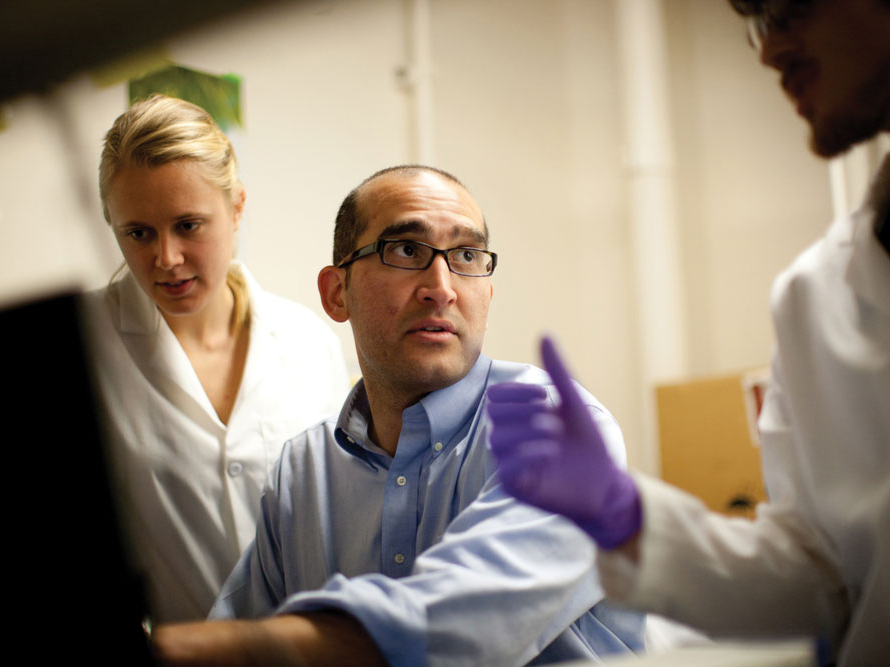
“I think it’s some of the most interesting work going on in all of biology right now,” said Moh El-Naggar, a biophysicist at the University of Southern California. El-Naggar studies how bacteria transfer electrons using specialized thin tubes, which he calls nanowires. Even though this transfer could also be considered a form of electrical communication, El-Naggar says that in the past, he would “put the brakes on” if someone suggested that bacteria behave similarly to neurons. Since reading Süel’s 2015 paper, he’s changed his thinking. “A lot of us can’t wait to see what comes out of this,” he said.
For Gemma Reguera, a microbiologist at Michigan State University, the recent revelations bolster an argument she has long been making to her biologist peers: that physical signals such as light, sound and electricity are as important to bacteria as chemical signals. “Perhaps [Süel’s finding] will help the scientific community and [people] outside the scientific community feel more open about other forms of physical communication” among bacteria, Reguera said.
Part of what excites researchers is that electrical signaling among bacteria shows signs of being more powerful than chemically mediated quorum sensing. Chemical signals have proved critical for coordinating certain collective behaviors, but they quickly get diluted and fade out once they’re beyond the immediate vicinity of the bacteria emitting the signal. In contrast, as Süel’s team has found, the potassium signals released from biofilms can travel with constant strength for more than 1,000 times the width of a typical bacterial cell — and even that limit is an artificial upper bound imposed by the microfluidic devices used in the experiments. The difference between quorum sensing and potassium signaling is like the difference between shouting from a mountaintop and making an international phone call.
Moreover, chemicals enable communication only with cells that have specific receptors attuned to them, Wingreen noted. Potassium, however, seems to be part of a universal language shared by animal neurons, plant cells and — scientists are increasingly finding — bacteria.
A Universal Chemical Language
The fact that microbes use potassium suggests that this is an ancient adaptation that developed before the eukaryotic cells that make up plants, animals and other life-forms diverged from bacteria, according to Jordi Garcia-Ojalvo, a professor of systems biology at Pompeu Fabra University in Barcelona who provided theoretical modeling to support Süel’s experiments. For the phenomenon of intercellular communications, he said, the bacterial channel “might be a good candidate for the evolutionary ancestor of the whole behavior.”
The findings form “a very interesting piece of work,” said James Shapiro, a bacterial geneticist at the University of Chicago. Shapiro is not afraid of bold hypotheses: He has argued that bacterial colonies might be capable of a form of cognition. But he approaches analogies between neurons and bacteria with caution. The potassium-mediated behaviors Süel has demonstrated so far are simple enough that they don’t require the type of sophisticated circuitry brains have evolved, Shapiro said. “It’s not clear exactly how much information processing is going on.”
Süel agrees. But he’s currently less interested in quantifying the information content of biofilms than in revealing what other feats bacteria are capable of. He’s now trying to see if biofilms of diverse bacterial species time-share the way biofilms of pure Bacillus do.
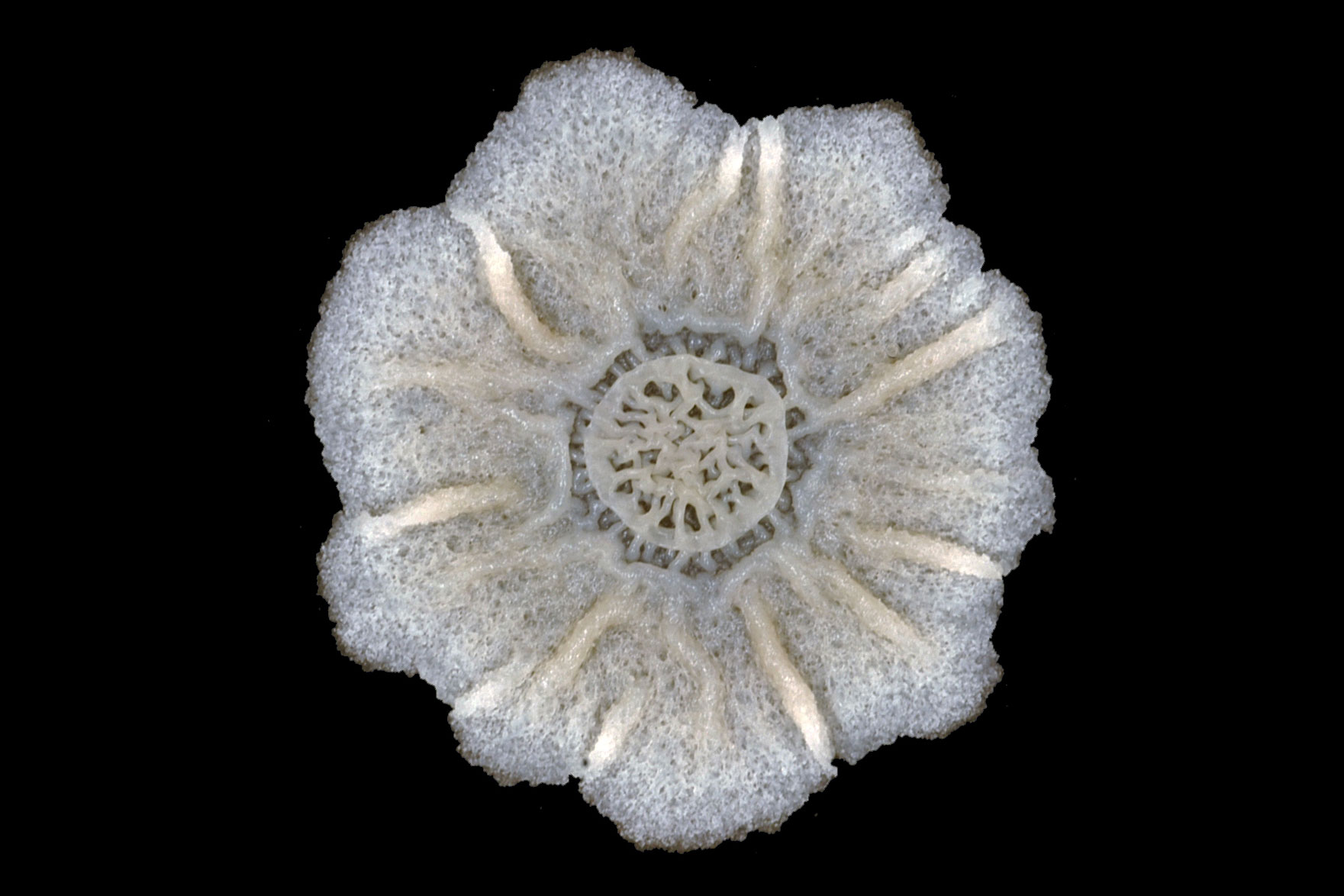
The view from above of a B. subtilis biofilm growing in culture. The varied structures within the biofilm relate to specialized functions that the cells in different parts of the biofilm assume.
He also wants to develop what he calls “bacterial biofilm electrophysiology”: techniques for studying electrical activity in bacteria directly, the way neuroscientists have probed the brain for decades. Tools designed for bacteria would be a major boon, said Elisa Masi, a researcher at the University of Florence in Italy who has used electrodes designed for neurons to detect electrical activity in bacteria. “We are talking about cells that are really, really small,” she said. “It’s difficult to observe their metabolic activity, and there is no specific method” for measuring their electrical signals.
Süel and his colleagues are now developing such tools as part of a $1.5 million grant from the Howard Hughes Medical Institute, the Bill and Melinda Gates Foundation, and the Simons Foundation (which publishes Quanta).
The findings could also lead to new kinds of antibiotics or bacteria-inspired technologies, Süel said, but such applications are years away. The more immediate payoff is the excitement of once again revolutionizing our conceptions about bacteria. “It’s amazing how our understanding of bacteria has evolved over the last couple decades,” El-Naggar said. He is curious about how well potassium signaling works in complex, ion-filled natural settings such as the ocean. “Now we’re thinking of [bacteria] as masters of manipulating electrons and ions in their environment. It’s a very, very far cry from the way we thought of them as very simplistic organisms.”
“Step by step we find that all the things we think bacteria don’t do, they actually do,” Wingreen said. “It’s displacing us from our pedestal.”
This article was reprinted on ScientificAmerican.com.
